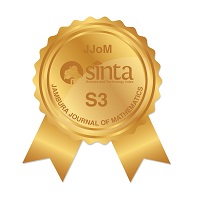Perbandingan Model ARCH (1) dan GARCH (1,1) Ditinjau dari Perilaku Kurtosis dan Fungsi Autokorelasi
Abstract
Keywords
Full Text:
PDFReferences
R. S. Tsay, Analysis of financial time series. New York: Wiley, 2002.
R. F. Engle, "Autoregressive Conditional Heteroscedasticity with Estimates of the Variance of United Kingdom Inflation" Econometrica, vol. 50, no. 4, p. 987, Jul. 1982, doi: 10.2307/1912773.
T. Bollerslev, "Generalized autoregressive conditional heteroskedasticity" J. Econom., vol. 31, no. 3, pp. 307-327, Apr. 1986, doi: 10.1016/0304-4076(86)90063-1.
H. Malmsten and T. Teräsvirta, "Stylized Facts of Financial Time Series and Three Popular Mod- els of Volatility" Eur J Pure Appl Math, p. 35, 2010.
R. Bilondatu, N. Nurwan, and D. R. Isa, "A Model ARCH (1) dan GARCH (1,1) pada Peramalan Harga Saham PT. Cowell Development Tbk." BAREKENG J. Ilmu Mat. Dan Terap., vol. 13, no. 1, pp. 009-018, Mar. 2019, doi: 10.30598/barekengvol13iss1pp009-018ar676.
C. M. Lim and S. K. Sek, "Comparing the Performances of GARCH-type Models in Capturing the Stock Market Volatility in Malaysia" Procedia Econ. Finance, vol. 5, pp. 478-487, 2013, doi: 10.1016/S2212-5671(13)00056-7.
H. Herwartz, "Stock return prediction under GARCH "” An empirical assessment" Int. J. Forecast., vol. 33, no. 3, pp. 569-580, Jul. 2017, doi: 10.1016/j.ijforecast.2017.01.002.
R. F. Engle and A. J. Patton, "What good is a volatility model?" Quant. Finance, vol. 1, no. 2, pp. 237-245, Feb. 2001, doi: 10.1088/1469-7688/1/2/305.
R. Cont, "Empirical properties of asset returns: stylized facts and statistical issues" Quant. Finance, vol. 1, no. 2, pp. 223-236, Feb. 2001, doi: 10.1080/713665670.
D. Ayuningtyas, "5 Saham LQ45 Beri Cuan di Atas 20%, Mari Simak Kinerjanya" market. https://www.cnbcindonesia.com/market/20191104102926-17-112353/5-saham-lq45-beri-cuan-di-atas-20-mari-simak-kinerjanya (accessed Feb. 27, 2020).
E. Zivot and J. Wang, Modeling financial time series with S-plus, 2nd ed. New York, NY: Springer, 2006.
C. He and T. Teräsvirta, "Fourth Moment Structure of The GARCH ( p , q ) PROCESS" Econom. Theory, vol. 15, no. 6, pp. 824-846, Dec. 1999, doi: 10.1017/S0266466699156032.
T. Bollerslev, R. Y. Chou, and K. F. Kroner, "ARCH modeling in finance" J. Econom., vol. 52, no. 1-2, pp. 5-59, Apr. 1992, doi: 10.1016/0304-4076(92)90064-X.
X. Bai, J. R. Russell, and G. C. Tiao, "Kurtosis of GARCH and stochastic volatility models with non-normal innovations" J. Econom., vol. 114, no. 2, pp. 349-360, Jun. 2003, doi: 10.1016/S0304-4076(03)00088-5.
C. Francq and J.-M. Zakoian, GARCH models: structure, statistical inference, and financial applications. Chichester, West Sussex: Wiley, 2010.
DOI: https://doi.org/10.34312/jjom.v2i2.4642
Copyright (c) 2020 I.K. Hasan, I. Djakaria, D.N.A. Karim

This work is licensed under a Creative Commons Attribution-NonCommercial 4.0 International License.
Jambura Journal of Mathematics has been indexed by
Jambura Journal of Mathematics (e-ISSN: 2656-1344) by Department of Mathematics Universitas Negeri Gorontalo is licensed under a Creative Commons Attribution-NonCommercial 4.0 International License. Powered by Public Knowledge Project OJS.
Editorial Office
Department of Mathematics, Faculty of Mathematics and Natural Science, Universitas Negeri Gorontalo
Jl. Prof. Dr. Ing. B. J. Habibie, Moutong, Tilongkabila, Kabupaten Bone Bolango, Gorontalo, Indonesia
Email: [email protected].



















